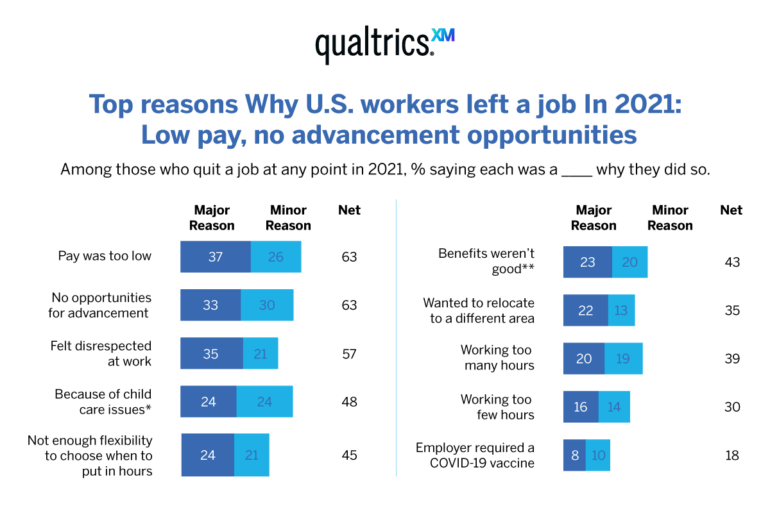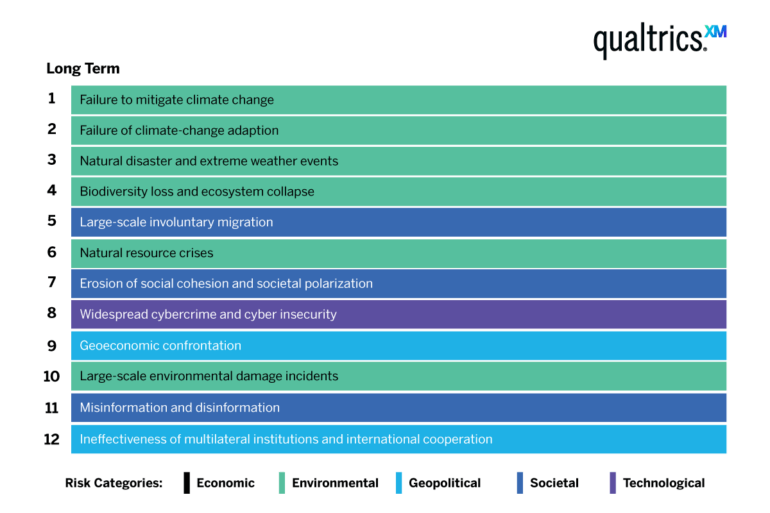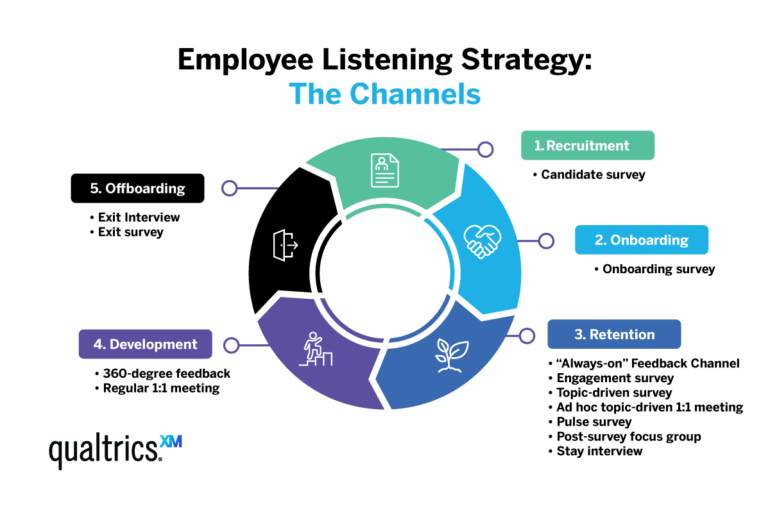
We define the future of work as the way we’ll do work over the next 10 years, shaped by societal, generational and technological changes. How has the nature of work evolved? And what can we do to keep up?
The future of work is already here. As we venture into 2023, it’s clear what’s driving the transformations and innovations in employee experience and employee expectations: the desire to:
- make business more human
- establish deeper, more meaningful connections through our work
The events of the past few years have not only been incredibly disruptive, they’ve also completely changed how we work. Some of these changes have become expectations and new norms, resulting in a dramatic shift in how many people perceive and do their work.
No industry went untouched — with many completely revising how they operate in today’s world. As a result, many employees are now revisiting and re-evaluating the offerings given by their organizations to ensure they’re still relevant and capable of serving their most basic needs, which are:
- Pay
- Benefits
- Well-being
- Work-life balance
- Efficient processes and systems
- Values
- Growth and development
Watch a limited release of the X4 Summit 2023 sessions on demand
The shifts that change how, where and when we work… for good
The COVID-19 pandemic
The pandemic, with its lockdowns, social distancing, and human toll had a huge impact upon the world of work.
Almost overnight, organizations were forced to adopt remote and hybrid-working models to serve their customers and empower their now isolated employees.
Yet remote working, which was the savior of many businesses during 2020/21, wasn’t new. The trend for working from home (WFH) and then working from anywhere (WFA) was becoming more accepted. COVID-19 just made it a necessity.
According to the McKinsey Global Institute, the pandemic forced companies and consumers to behave differently, and these new behaviors are likely to form the future of work:
- Remote work and virtual meetings are likely to continue, lessening the need for business travel, although with less intensity than at the peak of the pandemic.
- E-commerce grew 2x to 5x faster than before the pandemic, as well as online banking, telemedicine, and streaming entertainment on digital channels
- Automation and AI have been adopted faster, especially in a work environment where frontline workers were in close physical proximity to each other, such as in manufacturing plants
The Great Resignation
Between April 2020 to November 2021, the US national quit rate rose from 1.6% to 3% — the highest rate since government tracking began, and 47 million Americans quit their jobs.
The Pew Research Centre found that the top reasons for quitting were:
- low pay
- a lack of opportunities for advancement
- feeling disrespected at work

Before the pandemic, some organizations had unrealistic expectations of their workforce — pushing employees to go above and beyond what they were paid to do, and often asking them to stay late or complete tasks outside their remit.
In fact, workplace stress was contributing to 120,000 deaths and up to $190 billion in healthcare costs annually.
After the pandemic, many people were forced to work differently and saw their employers pivot almost overnight (e.g., office to remote work). This led many to form very different expectations around work and work-life balance and as a result many decided to change occupations and quit their jobs.
Quiet quitting
The term quiet quitting is slightly misleading. It’s not about physically leaving your job, it’s about performing your contracted work duties, and nothing more. As a modern signal of employee withdrawal, it can indicate that employees are consciously or unconsciously establishing boundaries to protect their time and resources. .
Qualtrics’s Employee Experience Trends 2023 Global Report found that employees who report good work life balance are about three times more likely to say they would go above and beyond than those who report poor work-life balance. They may be saying "I am willing to go above and beyond, but only if I have gas left in the tank."
Like WFA, quiet quitting wasn’t a new phenomenon. According to Gallup, between 13% and 20% of Americans reported being actively disengaged at work since 2000. They would simply do their job, go home, and not give it a second thought until the next day. In this way, it signals a move for some employees to treat work more transactionally.
The experiences of the last three years have spurred many workers to reassess their priorities, and the role of work in their lives.
Geopolitical and personal challenges
Work doesn’t exist in a bubble. It must acknowledge, react, and adapt to what is going on in the world. Which, at the moment, is a lot.
And in times of geopolitical instability, which in turn affect economies (we’re seeing this currently in the cost of living crisis), people want to be sure they have a secure job and are being paid a competitive salary to be able to afford their rising bills. Instilling confidence that your business is successful and can weather the storm is critical for your employee experience.
And the same geopolitical instability makes people want to work for organizations that demonstrate integrity and purpose in the face of adversity, and share their values about what is right. Younger workers in particular are motivated by and engaged with companies that demonstrate a commitment to upholding values, such as a commitment to addressing climate change, and social justice.
According to the International SOS Risk Outlook 2023 report, these are the five global risk predictions for 2023:
- The power of intelligence in decision making
- Geopolitical shifts, socio-economic challenges and increasing polarization
- Business and leisure travel requiring support
- Climate change and other forces increasing health risks
- Mental health in the workplace
And the World Economic Forum’s Top 12 long term risks are:

Looks like some challenging years ahead, doesn’t it? Yet, instead of focusing on what is changing - and change will always happen, no matter what - maybe we should focus on what doesn’t change about human nature and our psychology.
Dr Benjamin Granger says, “If we also look at what's true about human nature, e.g. humans are good at dealing with change when supported, humans have an innate need for affiliation, achievement, and control, etc., then this helps us anchor on universal truths no matter what comes at us in the future.”
In short, when we are equipped with the social and emotional skills, a sense of belonging, diversity (treating minorities, such as Black and Hispanic workers and white workers with equity) and inclusion (respecting everyone, from those with basic cognitive skills to those with a college degree), as well as developing existing employees’ technological skills, we can face whatever the future throws at us, head on.
The future of work trends for 2023 and beyond
As we’ve seen from the experiences and challenges above, all around the world employees are restructuring their relationship with work. They’re scrutinizing pay and benefits, reclaiming work-life boundaries, and choosing organizations that actively demonstrate their values.
Qualtrics’s Employee Experience Trends 2023 Global Report surveyed nearly 30,000 employees around the world to measure and understand how their experiences at work have changed. It highlights the most critical key actions that organizations can take to attract, retain and engage their people on a more human level.
These are:
Pay and benefits and job security
Just over half (57%) of those surveyed are satisfied with their current pay and benefits, and that satisfaction has dropped 10 points since last year.
Job security and financial certainty are the top priority for employees. Workers need to know that the organization they’re working for will carry on being successful into the future, and will pay them competitively.
Work-life balance, boundaries, and well being
When employees feel they have a good work-life balance, almost two-thirds (63%) are willing to go ‘above and beyond’ for their organization.
Going ‘above and beyond’ had become the expectation rather than the exception, with organizations leaning heavily on employees throughout the disruption - hence the prevalence of quiet quitting. Now employees are pushing back and reshaping their relationship with work to insist on healthy boundaries.
Better processes
Shockingly, more than a third (38%) of employees are experiencing burnout symptoms. They are likely to be less productive as a result. Ineffective processes and systems are the top driver of this burnout.
These past few years have completely overturned how organizations operate: from how they hire employees and the tools they use, to the processes and new technologies in place to get work done. These disruptions have hampered employees’ productivity and how they perceive it, and organizations may be taking too long to resolve them.
Aligned values
When employees feel that their organization embodies their own values, they’re 27% more likely to have higher engagement scores, and 23% more likely to stay working there for more than three years.
21st-century employees want to work for organizations that have values, integrity, and purpose. A modern organization’s values – and how effectively and consistently they’re demonstrated – drive its employees’ intent to stay.
Preparing for the future of work
Go beyond listening
You’ve moved beyond the annual engagement survey. You’ve gone beyond regular employee engagement surveys. You’ve put in place an employee listening strategy that encourages continuous dialogue and feedback.

Now, you need to go that bit further and incorporate tools that empower you to measure engagement more deeply and meaningfully. You need to go beyond surveys to develop truly holistic, enterprise-wide, and always-on strategies.
Mention the words ‘automation’ and ‘AI’ (artificial intelligence) to employees and many people will begin to fear for their jobs. Yet these are not necessarily about replacing people with machines. They’re about scaling processes so that people can move away from tedious, repetitive manual tasks that can disengage workers, and redeploying them to more strategic, interesting, value-adding functions.
A further, critical challenge for HR leaders is asking people to do more with less. Employees will rise to that challenge provided they are empowered by being given the right tools and support and are trusted to use their own initiative to problem solve.
By scaling their processes with automation and AI, particularly in the arena of employee experience, organizations can start to analyze greater swathes of data to achieve a more holistic picture of their employee experience. And when you have that holistic view, you can begin to create a workplace that’s fit for the future of work.
Futureproof your workplace culture
People are resilient, and they will make friends and connections naturally. The best thing you can do is create a supportive workplace environment that facilitates resilience and has a culture of belonging at its heart. Your employees will naturally do the rest.
With automation and AI, new cutting-edge technologies, and modern processes, it’s essential to keep training, upskilling, and reskilling your workforce so that they keep up to date.
It’s essential to invest in your employees, and the place to aim the investment is at frontline workers who really are the beating heart of your company. These are the people who deliver for the business and are customer-facing, so they are the first to spot issues and trends and pass them up the chain of command.
An example of the value of the frontline investment is Costco, which promotes from within most of the time. They are able to do this because many of their workers build their entire career with the company: they start at the bottom, maybe in the warehouse or shop floor, and work their way up - to senior management and even directorships. They know the business inside out because they have worked in every role. And this is because Costco chooses to treasure its frontline workforce.

Resist pigeonholing your workforce. Rather than rejecting job applicants who may not have a sufficiently hardcore STEM background, appreciate candidates from arts or humanities backgrounds. They tend to have ‘soft skills’ such as critical thinking, ethics, creativity and problem-solving that bring diversity of thought to the table. And anyway, you can teach them the nuts and bolts STEM skills they need for their job in hand. Creativity and lateral thinking is harder to teach.
Achieve work-life balance
Before, work life balance was something that employers ‘permitted’ employees to have — flexible working, time off, WFH. Now things are somewhat different. Employees have asked their employers to help them out with balancing work and home life, and where they’ve felt unsupported, they’ve taken the matter into their own hands.
With the skills shortage and the war for talent, employees are the ones calling the shots.They are saying ‘No!’ to employer demands, and pushing back to create their own boundaries. When an organization recruits well, and employs people whose values chime with theirs, there’s a lot of trust and goodwill.
Where the employer trusts the employee to get the job done wherever, whenever and however they work best, the employee can enjoy a good work-life balance while delivering great work, and maybe even going ‘above and beyond’ occasionally - because they want to.
Bridge the gaps between leadership and the frontline
There are three gaps between leadership and your frontline employees that you’ll need to fix if you want to make your organization fit for the future of work.
1. Trust gaps - Leadership may talk the talk regarding organizational behaviors and values, but do they walk the walk and model those themselves? When leaders embody ‘do as I say, not what I do’ and act as if those behaviors and values don’t apply to them, employees no longer trust management.
The solution? Recruit and promote self-aware managers who understand true leadership. Gather employee feedback about leadership, talk about the grievances then act to correct it.
2. Communication gaps - Most complaints about toxic work culture and employee disengagement spring from lack of communication, untruthful communication, miscommunication and being left out of decision-making. “They never tell us anything!”
The solution? Trust your employees to be able to handle the rough with the smooth. Create plans and protocols for good, constant communication. Ask the frontline (often) if communication has improved, and where it’s lacking.
3. Understanding gaps - The senior partner doesn’t understand the shop-floor worker in the food service department because they don’t spend enough time with each other to ‘get’ each other’s roles.
The solution? Time spent with your teams, mucking in with them and getting to know each other as people is time well spent.
Navigating the ever-evolving nature of work
The future of work is exciting, empowering, daunting and perhaps just a little scary right now. We want you to think about designing the workplace experience of the future, understanding what will motivate and retain your employees.
Come and listen to Benjamin Granger, Chief Workplace Psychologist at Qualtrics talking at EX4. He’ll be unveiling our latest research into exactly what employees want, so you can move forward with confidence into the future of work.
Watch a limited release of the X4 Summit 2023 sessions on demand